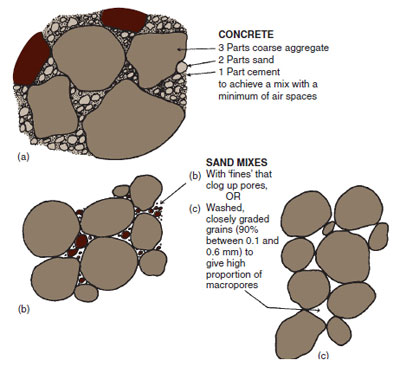Alternative growing media
Content
In addition to open ground or greenhouse borders, plants may be grown in pots, troughs, bags and other containers where restricted rooting makes more critical demands on the growing medium for air, water and nutrients. Soil is an inappropriate material to use in containers as it tends to collapse when kept wet; try watering a pot full of soil and note that it is not long before the container is only half full of soil. Soil is replaced in this situation by alternative growing media generally called composts. These materials are also called plant substrates, plant growing media, or just ‘mixes’ or ‘media’. Compost ingredients need to ensure adequate air space after wetting, with a stability to withstand prolonged watering without collapse. The need for the material to have good water-holding capacity depends on the irrigation system to be used. The nutrient content of the soil alternative needs to be allowed for and it is often advantageous to use one that has none as they can be added more precisely. The material should also be ‘partially sterile’ (free from pest and diseases) and free from toxics. Increasingly, in intensive production, the preferred alternative to growing in the soil is to use hydroponics. The weaknesses of soil for sportsground construction leads to its replacement with alternatives, e.g. graded sand on golf greens. Air-filled porosity (AFP) The importance of supplying water to plants in a restricted root volume is usually understood, but the difficulties associated with achieving it whilst maintaining adequate air-filled porosity (AFP) are less well appreciated. Roots require oxygen to maintain growth and activity. As temperatures rise the plant requires more, but the amount of oxygen that is dissolved in water decreases. Even in cool conditions, the oxygen that can be extracted from the water provides only a fraction of the roots requirements. So, unless the plants have special modifications to transport oxygen through their tissues, as in aquatic plants, there has to be good gaseous movement through the growing medium. Many large interconnected pores allow rapid entry of oxygen (see soil structure). Creating successful physical conditions depends on the use of components that provide a high proportion of macropores. It is generally considered that 10–15 per cent AFP is needed for a wide range of plants. Azaleas and epiphytic orchids require 20 per cent or more, whereas others, including chrysanthemums, lilies and poinsettia, tolerate 5–10 per cent AFP and carnations, conifers, geraniums, ivies and roses can be grown at levels as low as 2 per cent. Ensuring that a growing medium in a container has adequate air-filled porosity is made difficult because water does not readily leave the container unless it is in good contact through its holes with similar-sized pore spaces as when placed on sand or capillary matting. However, when standing out on gravel or wire the water will cling to the particles in the container (see surface tension). This can be tested by fully watering a pot of compost, holding it until it has finished dripping then touching the compost through a hole; normally a stream of water will run down your finger. Furthermore, unless stood out on appropriate material, the lower layers of the compost remain saturated (i.e. no air) irrespective of the height or width of the container. This makes it particularly difficult to get good aeration in shallow trays, modules and blocks. (You may understand this better if you fully wet a washing sponge and leave it to drain. After water has left the sponge under the influence of gravity, the lower layers remain saturated.)
Stability Very large quantities of water have to be applied to composts over the course of a season, so the materials chosen must have very good stability. Fine sand and silt soils collapse too quickly and reduce the size of the pore spaces. Even clay crumbs, unless reinforced with high humus content, collapse quite quickly. The sizes of the components used must be selected carefully to ensure that they create macropores, but also so that the gaps between the larger particles are not subsequently filled in by smaller particles (‘fines’). This is most easily achieved by using closely graded coarse particles. The reverse is achieved when combining many different-sized particles, as one would in mixing concrete, where the object is to minimize the air spaces as shown in Figure 22.2. Water-holding capacity The water-holding capacity of compost ingredients varies enormously. Peat is significantly better than most others. However, the importance of this depends on how the plants in the compost are to be irrigated. It is a major consideration if the plants are in small hanging baskets watered by hand and there are benefits in using absorbent polymers that improve water-holding more than peat alone. Peat presents a problem if it dries out, because it does not rewet easily unless treated with wetters. On the other hand, if there is to be a constant supply of water through one of the many self-watering systems, this water-holding capacity is far less significant and the emphasis should be on choosing material that is stable and provides the right air-filled porosity. |
||||||||||||||||||||||






